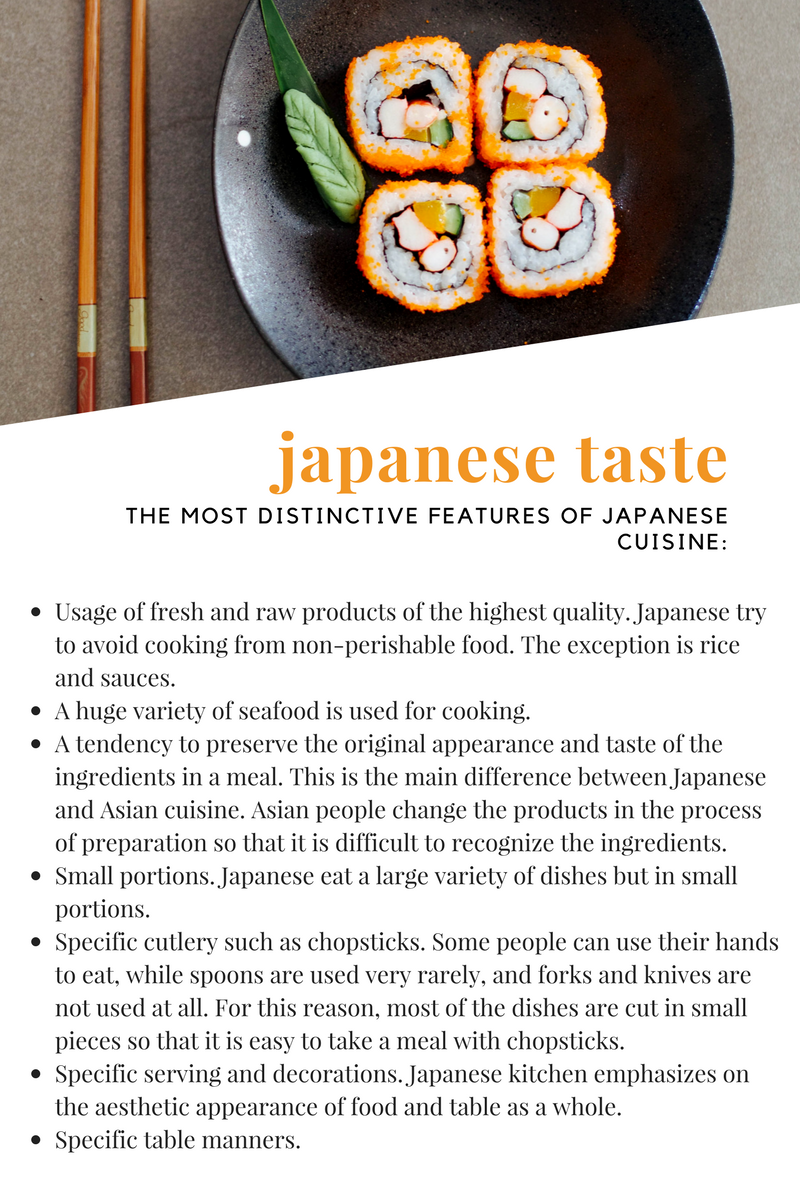The history of Japanese cuisine
The world of Japanese cuisine has a long history, which is changing over the centuries. It is rich in unique traditions and steady customs. It seems to be extraordinary and unusual for many Europeans. Perhaps, Japanese cuisine is an example of originality, diversity and usefulness, which is why it is one of the favorite food of many people living in different parts of the World. If you want to get a better taste of Japanese food, it is necessary to refer to its history, which dates back to many centuries ago.
Japan is a country with rich flora and fauna. Therefore, the population of this country has never had any problems with getting enough food for a normal existence. Even many centuries ago, the Japanese people had about 20 different species of plants in their food ration, could cook different dishes from more than 120 kinds of meat, as well as prepare dishes from multiple fish species and shellfish.
History and food
Different food traditions of other nations have influenced the Japanese cuisine. Thus, it has created and adopted its unique customs and recipes over the centuries.
It is known that Chinese people showed Japanese how to cultivate rice in 300 B.C. No wonder that Chinese showed how to use chopsticks, as well as introduced the usage of soy sauce and tofu in everyday life.
Later in 700 A.D., meat consumption was prohibited by Buddhists. Buddhism introduced dishes made from raw fish and rice to Japanese people. By the way, it still remains one of the main religions in Japan.
Vegetarian dishes became popular in 1800-s. The recipes became simpler and people divided all dishes into 5 color classes and 6 tastes.
Color groups:
1) red
2) green
3) white
4) yellow
5) black-purple
Taste classes:
1) sweet
2) sour
3) bitter
4) salty
5) hot
6) delicate
Japanese chefs and restaurants still use this system in their recipes.
In 1200-s, trade between the different countries has become popular. Japanese cuisine mixed with Dutch and Portuguese. It incorporated potatoes, corn, and sweet potatoes. Then, a frying technique “tempura” became popular.
During the 20th century, Japanese cuisine involved bread, ice cream, coffee and other western foods. Nevertheless, Japanese still cherish their traditions and opt for classic cooking recipes.
The most distinctive features of Japanese cuisine:
-
Usage of fresh and raw products of the highest quality. Japanese try to avoid cooking from non-perishable food. The exception is rice and sauces.
-
A huge variety of seafood is used for cooking.
-
A tendency to preserve the original appearance and taste of the ingredients in a meal. This is the main difference between Japanese and Asian cuisine. Asian people change the products in the process of preparation so that it is difficult to recognize the ingredients.
-
Small portions. Japanese eat a large variety of dishes but in small portions.
-
Specific cutlery such as chopsticks. Some people can use their hands to eat, while spoons are used very rarely, and forks and knives are not used at all. For this reason, most of the dishes are cut in small pieces so that it is easy to take a meal with chopsticks.
-
Specific serving and decorations. Japanese kitchen emphasizes on the aesthetic appearance of food and table as a whole.
-
Specific table manners.
The most commonly used ingredients in Japanese cuisine are rice, seafood, soy, beans and noodles.

People mistakenly assume that Japanese people eat only sushi day and night (made from rice and raw fish). There are many other delicious and nutritious meals in their diet. For example, a salad made from seaweed seasoned with soy sauce and ginger.
Various soups cooked from fish or vegetables, with shiitake mushrooms and soy tofu are very popular in Japan. Japanese people are true sweet tooth, but their desserts are quite specific. Instead of chocolate and whipped cream they make ice cream from green tea and mocha. One of the most popular desserts is a traditional cake made of crushed glutinous rice. It is believed that national cuisine and fresh products brought the Japanese people longevity and good health.
Related posts:
- The history of fast food
- What to eat during the autumn and winter to be in the shape
- Yoga for better digestion
- Secrets of long life: What to eat to live to a hundred years
- Everything you need to know about carbohydrates
- How to eat desserts and lose weight
- An easy recipe for those who goes crazy with caramel popcorn
Was this article useful for you? Our team of professional writers and editors will help you to create original and flawless academic papers from scratch or edit existing ones.
Popular Topics:
- Editor online: Top 10 Grammar Mistakes
- Edit my paper: Who Are Copyeditors?
- How to proofread my paper: basic rules
- Six Signs That You Need To Order Academic Editing Services
- Best Essay proofreading service: How to proofread my essay?
- Thesis editing tips: how to improve your thesis?
- How to finish off the academic paper?
- How to choose online essay editor?
- Things you should avoid in academic writing
- Online paper editing: students’ choice
